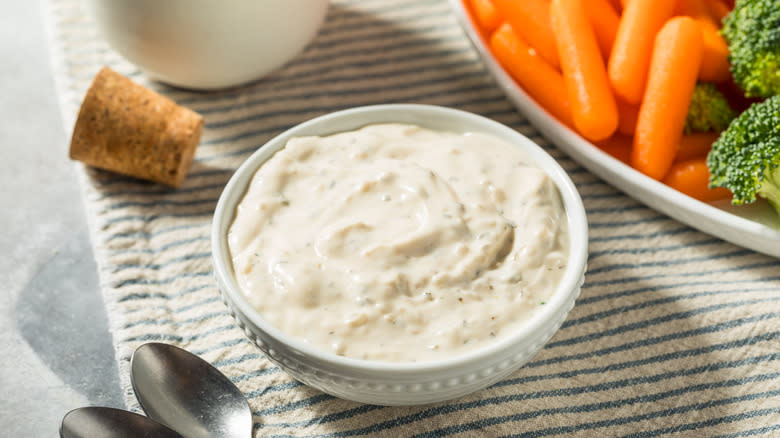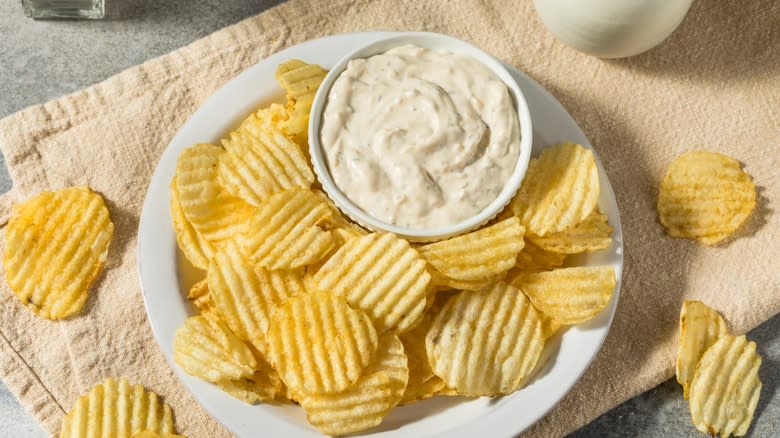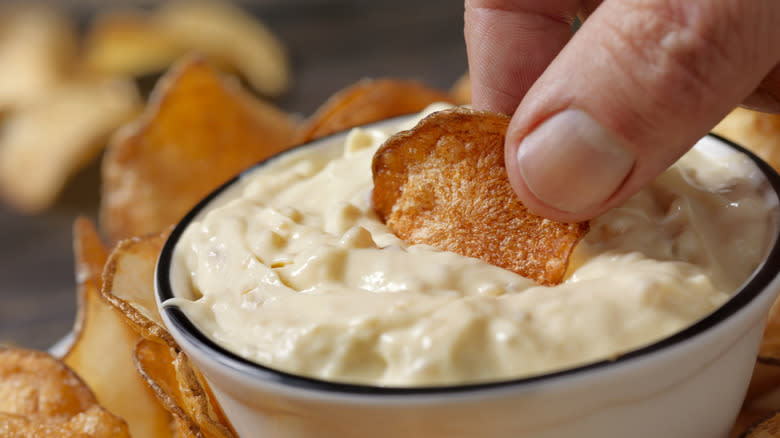The 2-Ingredient Onion Dip That's A Been A Crowd-Pleaser For Decades

You've probably had it at a birthday party growing up or made it for that Super Bowl party you've invited all your friends to –– French onion dip has largely stood the test of time. All that boils down to convenience and the ease of making the party food. Unlike more complicated homemade dips, this easy version requires no cooking. You only need two ingredients: Lipton's onion soup mix and some sour cream. Blend the onion soup mix with the sour cream, and it's ready to serve.
It's that convenience that made Lipton's onion dip popular in post-World War II America. Although many refer to it as French onion dip, there's nothing French about it. It's American-born, as it was created in California sometime in 1954. Not even Lipton knows who first made the dish, but the soup company played a role in promoting the dip as a way of selling more of its own product. "I think the main arguments about why this rose to popularity would be political and social," Adrienne Bitar, author of "Diet and the Disease of Civilization," told Food52.
There were other onion dip recipes before Lipton's hit the scene, but they required a more laborious creation with multiple ingredients such as wine, mayo, and cream cheese. In post-World War II America, consumers were more willing to consume processed and dehydrated foods. In particular, dehydrated soups became popular thanks to being easy to fix.
Read more: 12 Discontinued Store-Bought Soups We Aren't Getting Back
How This Onion Dip Became Popular

Lipton capitalized on America's growing need for convenience. Through the 1950s, the soup company ran ads in newspapers throughout California, seeing increased sales. The company also started putting the recipe on the back of its onion soup mixes. Partnering with Arthur Godfrey, host of the popular "Talent Scouts" program, Lipton brought the recipe to Americans nationwide. The recipe was printed in national magazines and newspapers; a public blitzkrieg seemed to work as the dip became a hit with many. That popularity has lasted through the decades.
Over the years, Lipton has tried to broaden its success with the onion dip through variations on the original recipe. For a time, consumers experimented with new takes on the onion dip for their parties. The 1960s saw the rise of a seafood-inspired shrimp onion dip as well as a vegetable take on it. Some more bold culinary adventurers even whipped up a batch of onion dip-deviled eggs. It wasn't uncommon to find the dip mixed with blue cheese or mashed avocado for some extra creaminess. However, many of these recipes seem to have gone the way of the dodo (at least for most Americans), while the classic tried-and-true onion dip remains. They say nostalgia is a powerful drug, which may explain the continued popularity of the two-ingredient onion dip. Besides convenience, nostalgia played an essential role in the dip's lasting appeal, with the recipe now harkening back to simpler times for many.
Nostalgia Keeps The Onion Dip Alive

Many likely have memories of their grandparents fixing the dip for birthday parties, holidays, or other family occasions. While many have recently turned their noses to processed foods, it seems that Lipton's onion dip hasn't fallen out of style. That's thanks to the nostalgia of its flavor. Sure, you can go through the task of cooking onions and spend time in the kitchen throwing ingredients together, but it will never taste the same as the simple two-onion dip you had as a child. That may explain why Lipon reports an increase in sales annually, starting in November until Super Bowl Sunday.
The rise of Lipton's onion dip was very much a product of its time. The 1950s brought the all-electric kitchen; refrigerators and freezers became familiar mainstays rather than rarities. Thus, it was easier for families to keep cold products like sour cream in their kitchens longer. Likewise, the decade saw an increase in women entering the workforce. Participation rose in 1948, but things picked up in the 1950s and the following decades as many women shrugged off the housewife image of generations past. With two parents working rather than at home, families began to search for convenience in their meals, with many lacking the time to spend all day preparing breakfast, lunch, and dinner. The 1950s saw Americans embrace processed foods as food manufacturers grew in prominence.
Read the original article on Daily Meal.

 Yahoo Finance
Yahoo Finance 